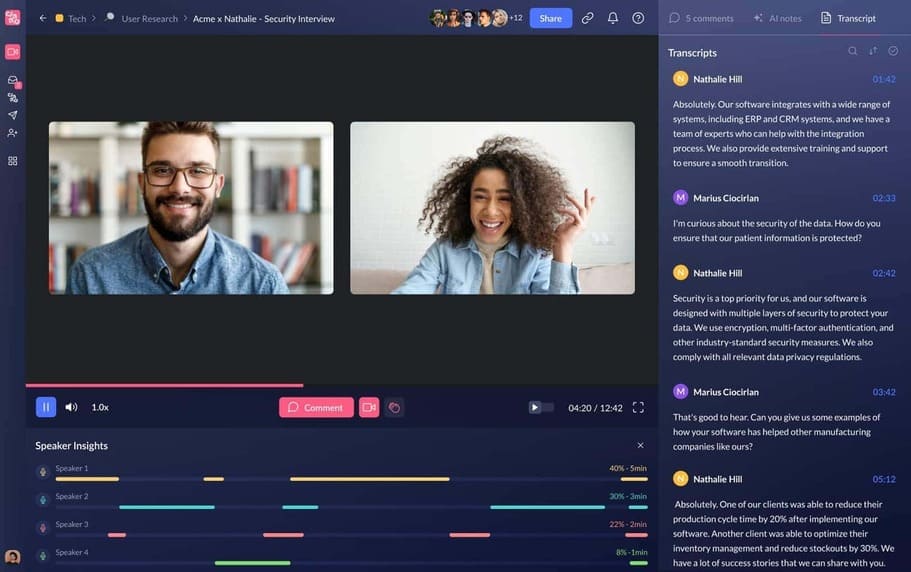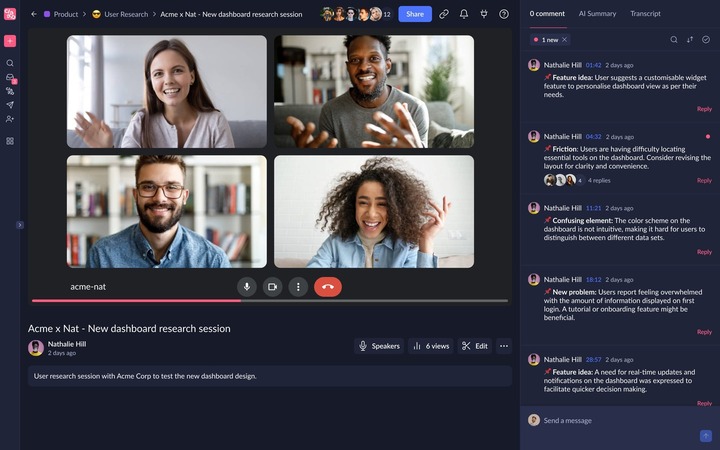
The Ultimate Guide to recording interviews: Tips and Techniques
Why do you need to record interviews?
Types of interviews
There’s an infinite amount of reason to have interviews, but to keep things simple here are the most common ones:
- Job Interview: An interview between an employer and a candidate applying for a job.
- UX Interview: An interview between designers and product users to gather insights on their experiences and preferences.
- Research Interview: An interview with experts or individuals with relevant knowledge, to collect in-depth information for market or scientific research.
- Journalistic Interview: An interview conducted by reporters to obtain first-hand information and quotes for news stories.
In-person vs remote interviews
Interviews can be carried out through two main methods
- In-person: Participants gather at the same physical location for direct discussion.
- Remotely: Participants are situated in different locations and communicate through a video meeting platform.
Regardless of the approach, there are strong reasons to consider recording these interviews. Form self improvement to information sharing, let's explore these reasons together.

The 3 benefits of recording interviews
I can't emphasize enough the importance of recording your interviews, as it offers three primary advantages:
- Uninterrupted Access to Information: Recording interviews provides you with the ability to revisit the content whenever needed, facilitating review, deeper understanding, and analysis.
- Effortless Content Sharing: When you record an interview, you can effortlessly highlight key moments and share them with your team to gather feedback.
- Freedom from Note-Taking: Recording interviews eliminates the need for meticulous note-taking to retain information. This allows you to fully engage in your conversation and make a real impact!
- Track Every Word That’s Said: By recording your interviews, you’ll have a log of every word that’s been said. Partner this with technology that turns these into transcripts and you’ve got an unstoppable knowledge database.
For a substantial productivity boost, consider using Claap to record your meetings. Claap is an all-in-one meeting recording software that not only automatically transcribes your meetings but also shares them efficiently with your team.

7 PRO tips to master the art of recording interviews
Use a note-taking tool
When conducting interviews, it's crucial to ensure you ask relevant questions and capture essential information.
Your brain is powerful but not enough to remember every word people say. Another option could be you try writing down what people say as they say it with a pen and paper, classic.
But then you lose focus and become someone watching the interview rather than being in it.
Use an automatic note taker like Claap to get a complete transcript of what everyone said to stay organized, focused, and efficient when it comes to meetings.

Prepare questions beforehand
Having a well-prepared set of questions in advance will allow you to maintain the flow of the conversation and ensure you cover all the necessary topics. Crafting thoughtful and relevant questions tailored to your specific interview type will lead to more informative and engaging discussions.
Have your equipment ready
Before starting your interview, it's essential to have your recording equipment ready. Make sure your device is fully charged to prevent any unexpected interruptions. Additionally, having a backup plan in place, whether it's a spare battery or an alternative recording device, ensures that you can capture every important moment without a hitch.
Make a test recording before starting
To ensure your device is primed for the best recording quality, it's wise to conduct a test recording before your actual interview. If you're using a remote meeting tool, take a moment to familiarize yourself with how to initiate and manage the recording process. It is very easy and intuitive on tools like Claap.
Avoid noisy places (In-person interviews)
When conducting in-person interviews, it's crucial to select a quiet and conducive location. Avoid noisy places to ensure that your interview remains free from distractions, allowing for clear communication and high-quality recordings.

Ask for permission before recording
While some regions operate under one-party consent laws, allowing you to legally record without explicit consent, it's always best practice to ask for permission or notify your interviewee. Not only does this demonstrate respect for their privacy, but it can also help foster a more open and cooperative interview environment.
Minimize interruptions
During an interview, it's advisable to minimize interruptions as much as possible. Allowing the interviewee to express their thoughts and ideas without frequent interruptions not only ensures a smoother and more productive conversation but also results in clearer, more natural recordings.
What are the best recording tools for interviews?

What is the best recording tool for an in-person interview?
In the case of in-person interviews, the ideal recording tool often requires a specific device such as a camera or a high-quality voice recorder to capture the nuances of face-to-face conversations. For a detailed exploration of the best devices for in-person interviews, please check out our dedicated article on best recording devices.
What is the best recording tool for a remote interview?
I might be biased but Claap is for me the best recording tool for a remote interview. Here is why:
- Meeting Recorder: Claap is compatible with Zoom and Google Meet and allows you to record your conversations with a single click.
- Automatic note-taker: Say goodbye to the need for manual note-taking during your interviews. Claap's audio and video transcription capabilities ensure precise transcriptions of live interviews and uploaded video recordings.
- AI Summary: Claap harnesses AI-powered features to extract key ideas from your notes, structuring and integrating them into your templates, supercharging your productivity.
- Powerful editing tools: With Claap’s editing tools, you have the flexibility to tailor your recorded interviews to meet the specific needs of your audience. For instance, you can create specific sections in the video. This allows you to make your videos more user-friendly and audience-appropriate, whether you're sharing them with your teams or the public.
- Collaboration features: Claap elevates teamwork with features such as the ability to comment or react to specific parts of the recorded interview, maximizing engagement and interaction.
- Intuitive and complete workspace: Claap offers an intuitive video wiki and a workspace organized into categories, simplifying video storage and sharing with your teams.
But as they say, seeing is believing. Don't wait any longer, give Claap a try here and experience it for yourself (free plan available with no credit card required)!



